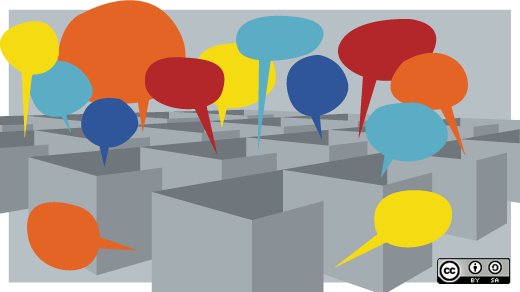Most people are familiar with university foreign exchange programs, where schools send their star students out into the world to collect experiences and learn beyond their comfort zones. Fewer people probably know that big companies have internal "executive MBA" programs their HR departments develop to help fast-track top performers (we have our own such programs here at Red Hat). Recently, I acted as a subject matter expert for a corporate executive development program with high performing General Electric (GE) executives. The day I spent with these leaders was one of my favorites here at Red Hat, and it dawned on me that this could potentially be a sharing model that Red Hat and others could use more broadly.
These folks were some of GE's brightest talents, tasked with the challenge of understanding how to build "digital DNA" into a hundred year-old company. It was a three-week project GE set up as a tour of various organizations GE felt had mastered the art of building this digital DNA and creating a culture tailored to the millennial generation. The company wanted its emerging leaders to learn everything they could about the way workplaces are changing in the digital age.
So as part of their tour, they stopped by Red Hat's Atlanta offices to learn more about our company's unique culture. When I first received GE's request, I felt baffled that the company thought it had something to learn from Red Hat. The fact that a high-profile company like GE continues to evaluate its corporate culture and is willing to reach beyond its walls really impressed me. It was also refreshing that these leaders were so candid about the challenges GE faces as it evolves from an industrial goods company to something much more.
As luck would have it, I had a handy resource right at my fingertips—my boss’s new book, The Open Organization! Our CEO, Jim Whitehurst, writes about how open source principles have dramatically altered the future of management and organizational leadership. I gave each of our visitors a copy of Jim's book (as well as Charlene Li's recent book, The Engaged Leader), and we began a several-hour discussion, talking openly about the cultures of our two companies.
Sharing stories of everyday life in our organizations was a great way to break the ice. The GE folks and I may have worked in very different places, but we soon discovered we shared similar concerns:
-
How do we ensure our companies innovate and respond quickly enough to our fast-paced market environments?
-
How can we stay agile so that decision-making doesn't suffer as we continue to grow?
-
How do we continue to attract and retain up-and-coming workers who demand more autonomy and purpose at work?
-
How do we maintain what we're known for while also being flexible and adaptable for what is coming?
Our conversation was enlightening for both sides. For example, we discussed at length the place and role of metrics in organizations today. We all agreed that becoming obsessed with the most minute details of numbers was a constant danger, especially given the flood of information now available. But our visitors were clearly shocked when I told them Red Hat doesn't track the kinds of metrics GE does. Instead, Red Hat leaders expect associates to define their goals and corresponding metrics, because we trust the judgment of the people closest to the problems we're trying to solve collectively. And we feel associates can make these decisions because we've ensured that they all thoroughly understand the company's mission, purpose, and strategy. I was being completely honest when I told our visitors that I've never lost a wink of sleep wondering whether Red Hatters understand and embrace our mission. That's just something I take for granted in an open organization like ours.
We also discussed the role feedback plays in our decision-making practices. I told GE leaders how lucky I feel to be working closely with associates who'll tell me when something isn’t going well (or when they don't agree with me!). I have zero fear that people on my team are just nodding in agreement, or that issues will grow so large that they become extremely difficult to fix. When we have an issue or conflict in Marketing at Red Hat, we tend to set up quick (30-day), cross-functional "tiger teams" to hit the problem straight on. In traditional organizations, mandates and solutions tend to flow from leaders down to their subordinates, whose job is to carry out those mandates—not question them. Today's workforce is smarter than I am; I need their insights and creativity to find the right solutions. And they demand—and deserve—a culture that values their input, not simply their obedience. Open organizations tend to attract this kind of talent, I said.
During the visit, I was actually able to demonstrate firsthand the power of an open organization's collaborative atmosphere. Red Hat CIO Lee Congdon joined me so we could explain how we partnered together as CIO-CMO (an increasingly hot topic these days). We used our joint effort of re-launching redhat.com as a specific example. As anyone who's built something of this size knows, constructing a website like ours involves multiple stakeholders with all kinds of talents. A website needs to be technically sound (well programmed and speedy), but also easy to navigate and beautiful to look at. It should also embody a company's voice and brand. So when we set to work overhauling redhat.com, we formed a collaborative working group composed of experts in both web design and branding. It was another wonderful cross-cultural experience, as designers learned to work according to the principles of agile development, and developers learned to build resources that reflect our brand. We were proud to tell our visitors about such a successful partnership.
In the end, our new friends from GE felt like they'd gleaned some practical tips for continuing to evolve GE's corporate culture. They especially appreciated the way each of the Open Organization’s chapters ends with concrete and actionable tips from Jim for making a workplace more open, collaborative, transparent, and meritocratic—all characteristics they'd like to foster in the GE of the future. Shortly after we parted, I received a note from one of the attendees, who thanked me for helping the group explore issues they otherwise "couldn't see by looking in the mirror."
Follow the conversation on Twitter #theopenorg






6 Comments